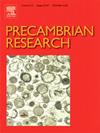Identification of survived Archean continental fragments in the Paleoproterozoic Trans-North China Orogen
IF 3.2
2区 地球科学
Q2 GEOSCIENCES, MULTIDISCIPLINARY
引用次数: 0
Abstract
The late Archean granulite was found as tectonic slices amalgamated with the late Paleoproterozoic metamorphic rocks in the Pingquan area within the Paleoproterozoic Trans-North China Orogen. The late Archean intermediate granulite rocks with distinctive ‘red-eye socket’ texture record anticlockwise P-T paths and were metamorphosed at ∼2.5 Ga, whereas the late Paleoproterozoic mafic granulite and amphibolite with “white-eye socket” texture record clockwise P-T paths and were metamorphosed at 1.86–1.80 Ga. The 40Ar/39Ar ages (1.81–1.79 Ga) of hornblende further constrain the synchronous exhumation of these disparate metamorphic units, providing critical constraints on the Paleoproterozoic uplifting and cooling process. The juxtaposition of late Archean continental fragments with Paleoproterozoic subduction-related lithologies within a confined orogenic zone highlights the capacity of orogenic systems to preserve both juvenile accreted terranes and reworked more ancient continental fragments, implying remarkable longevity of continental materials through accretionary cycles. This phenomenon suggests that without detailed metamorphic-petrochronological analyses, amalgamated tectonic slices formed at different ages may remain unresolved, potentially leading to erroneous interpretations.
古元古代跨华北造山带现存太古代大陆碎片鉴定
晚太古代麻粒岩是在古元古代跨华北造山带平泉地区与晚古元古代变质岩合并的构造片。具有“红眼窝”结构的晚太古代中间麻粒岩记录逆时针P-T路径,变质时间为~ 2.5 Ga,而具有“白眼窝”结构的晚古元古代基性麻粒岩和角闪岩记录顺时针P-T路径,变质时间为1.86 ~ 1.80 Ga。角闪石的40Ar/39Ar年龄(1.81 ~ 1.79 Ga)进一步限制了这些不同变质单元的同步发掘,为古元古代隆升和冷却过程提供了关键约束。在一个封闭造山带内,将晚太古代大陆碎片与古元古代俯冲相关的岩性并置,突出了造山带系统既保存了幼年增生地体,又重新加工了更古老的大陆碎片的能力,这意味着大陆物质在增生旋回中具有显著的寿命。这一现象表明,如果没有详细的变质岩石年代学分析,不同时代形成的合并构造片可能仍未得到解决,从而可能导致错误的解释。
本文章由计算机程序翻译,如有差异,请以英文原文为准。
求助全文
约1分钟内获得全文
求助全文
来源期刊

Precambrian Research
地学-地球科学综合
CiteScore
7.20
自引率
28.90%
发文量
325
审稿时长
12 months
期刊介绍:
Precambrian Research publishes studies on all aspects of the early stages of the composition, structure and evolution of the Earth and its planetary neighbours. With a focus on process-oriented and comparative studies, it covers, but is not restricted to, subjects such as:
(1) Chemical, biological, biochemical and cosmochemical evolution; the origin of life; the evolution of the oceans and atmosphere; the early fossil record; palaeobiology;
(2) Geochronology and isotope and elemental geochemistry;
(3) Precambrian mineral deposits;
(4) Geophysical aspects of the early Earth and Precambrian terrains;
(5) Nature, formation and evolution of the Precambrian lithosphere and mantle including magmatic, depositional, metamorphic and tectonic processes.
In addition, the editors particularly welcome integrated process-oriented studies that involve a combination of the above fields and comparative studies that demonstrate the effect of Precambrian evolution on Phanerozoic earth system processes.
Regional and localised studies of Precambrian phenomena are considered appropriate only when the detail and quality allow illustration of a wider process, or when significant gaps in basic knowledge of a particular area can be filled.
 求助内容:
求助内容: 应助结果提醒方式:
应助结果提醒方式:


